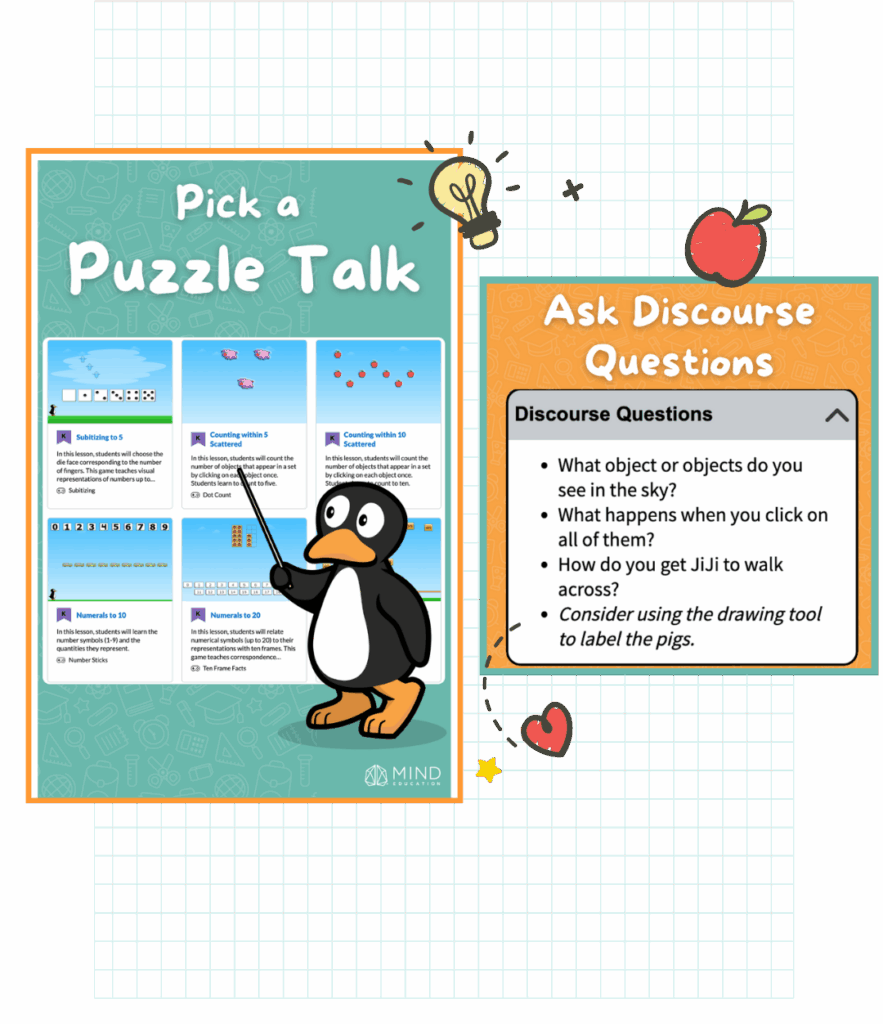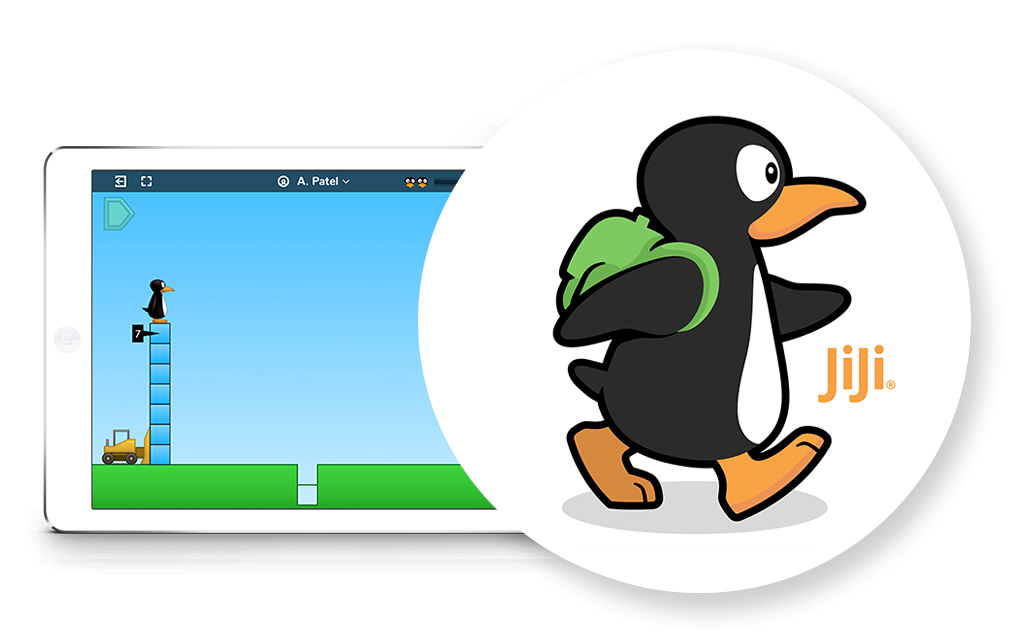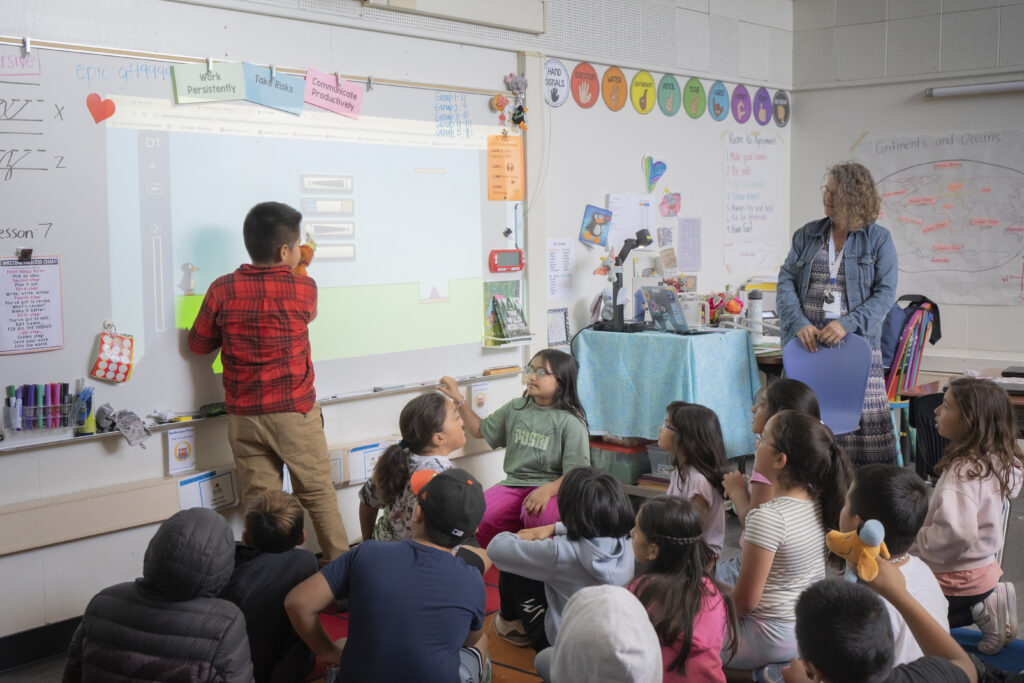Try Puzzle Talks
Puzzle Talks
Math classroom discourse made easy.
Puzzle Talks are a great way to engage students in conceptual math puzzle and fun classroom discourse.

Try Free Puzzle Talks
Easy math discourse across K-8 topics.
5-15 minute whole class discussions using discourse questions. Teachers ask questions to get students talking about how to get JiJi®, the math penguin, past obstacles and across the screen.

Join our Puzzle Talks Community.
Get started today in 4 easy steps!
1. Select a Puzzle Talk
Select a Puzzle Talk. Privately, watch the “Game in a Minute” to see how the puzzles work.
2. Start your first Puzzle Talk!
Start your first Puzzle Talk. Click “Start” and display the puzzle on a large screen for whole class viewing.
3. Ask Discourse Questions
Ask discourse questions. Click on “Teacher Notes” and ask students the notice and wonder questions.
4. Try a Variety of Solutions
Try a variety of solutions, not just the ones that could be successful.
Solve Together. Learn Together.

Blog: Encouraging Math Discourse
Want to learn more about Puzzle Talks?
Frequently Asked Questions
How do I start a Puzzle Talk?
Submit the form at the top of this page to access the Puzzle Talks library.
Choose a Puzzle Talk and display it on a large screen for entire class viewing, then press the “Start” button.
The puzzle appears without instructions, igniting student curiosity about how to solve it.
Select “Teacher Notes” to reveal the math discourse questions.
Ask students the included notice and wonder questions.
Try out different solutions with the whole class, and learn from mistakes to solve the puzzle.
Visit our Puzzle Talks Resources Page to get full access to teacher facilitation guides, hand signal posters, engagement strategies, weekly planning guides, and more!
Want a detailed walk-through? Watch this Puzzle Talks Webinar!
Where do I find the math discourse questions?
Each Puzzle Talk includes a unique set of engaging discussion questions specifically designed for that puzzle, aimed at helping JiJi®, the math penguin, navigate obstacles and move across the screen.
While engaging in the Puzzle Talk, select “Teacher Notes” located at the bottom left corner of the puzzle.
As students begin to share their responses to the discussion questions, you can prompt further deep thinking with these additional questions:
1. How did you figure that out? Show me.
2. Why do you think that is the answer?
3. What do you mean by [math term]?
4. Where have you seen this before?
Access this guide for additional strategies on engaging with students during Puzzle Talks: Mathematical Discourse Facilitation Guide PDF.
Can I preview how to solve the Puzzle Talk?
Certainly! The majority of the Puzzle Talks feature a “Game in a Minute” video.
Watching the “Game in a Minute” video allows teachers to quickly understand the puzzle’s solution and how to assist JiJi, the math penguin, in moving across the screen.
This aids teachers in posing further conceptual problem-solving questions to students who may be struggling, by discussing solutions and exploring strategies for solving the puzzle.
Are there tips for navigating Puzzle Talks?
Yes! Puzzle Talks are easy to find and navigate, but there are some navigation tips and tools we don’t want you to miss!
Check out the Puzzle Talks Platform and Navigation Tools page for comprehensive information.
Are these Puzzle Talks designed with a neuroscience approach?
Yes! At MIND Education, our 25+ years of neuroscience research reveals how the brain learns best, emphasizing deep, active learning – and we’ve built it into Puzzle Talks.
Our approach ensures students learn by doing, fostering creativity and critical thinking.
This active engagement prevents the passive learning trap of merely seeking the right answers, equipping students with the skills needed to tackle real-world problems.
It is based in the perception action cycle of our brains, detailed here:
Whenever we’re tasked with solving a problem, we use our existing schema to make a prediction, “Here’s what I think will happen.”
Then, we take action and the consequences of our choices are revealed. We perceive the outcome, literally by seeing it, and inside the brain – in the hippocampus – the prediction we made is compared to our perception.
If we are correct, our prediction and perception match, and the schema that caused us to make that prediction is strengthened.
This is how we build schemas and conceptual understanding. But learning doesn’t just happen when you get things right.
Imagine a different schema fired up causing us to make a different prediction and take a different action. Again, we perceive the outcome.
Again, in the hippocampus, our perception is compared to our prediction. But this time they do not match.
First, the hippocampus sends a signal that de-prioritizes that schema. So, the next time we see a problem like this, this schema is much less likely to influence our thinking. This is how misconceptions are rectified.
A second signal is also emitted from the hippocampus that tells the brain, “You need to learn something new-you need to build new schema.”
The idea that students learn through their mistakes is very accurate and is based upon this fundamental neuroscience.
This is what happens in every single Puzzle Talk puzzle.
Will my students get better at math discourse with Puzzle Talks?
Yes! Engaging in math discourse can help students develop a variety of important skills, such as:
⏺ Deep conceptual understanding, which enhances learners’ understanding of math concepts beyond rote memorization.
⏺ Clarity of thinking, as articulating one’s reasoning and problem-solving strategies requires a clear and organized thought process.
⏺ Math discourse also fosters the development of mathematical language, enabling learners to comfortably communicate complex ideas. This shared language is crucial for bridging gaps in knowledge and building upon existing concepts.
⏺ Additionally, by exposing learners to a variety of problem-solving approaches, math discourse encourages the development of different strategies, enriching their analytical toolkit and critical thinking skills.
Math class shouldn’t be about right and wrong answers. It should be about facilitating conversations that lead to multiple pathways of problem-solving and foster a deeper conceptual understanding of math.
Do Puzzle Talks help students learn the WHY of math concepts?
Yes! Puzzle Talks utilize interactive technology to encourage students to encourage students to experiment with ideas and immediately understand the WHY behind the success or failure of a strategy.
Discourse questions guide teachers to help students encourage deep thinking, and extend thinking to new and familiar math concepts.
For this reason, mistakes aren’t a big deal. They aren’t heavy, nor to be avoided. They are one of learning’s greatest untapped resources.
This empowers educators to guide students through personalized learning experiences, from initial struggles to eventual triumphs.
Puzzle Talks signify a transformation, harnessing technology to provide conceptual, interactive, and deeply engaging education experiences.
Will my students learn Big Ideas concepts with Puzzle Talks?
Yes! A new paradigm is emerging that aims to empower us by teaching Big Ideas.
Big Ideas can be thought of as interconnected concepts or schemas that students can deeply understand and apply.
While traditional standards are typically covered in a short period of time, Big Ideas are explored throughout different grade levels and can continue to be relevant in advanced studies.
These foundational concepts in elementary school are enduring and provide a strong basis for future mathematical explorations.
Through the early years of the 2000s, we were rapidly iterating our program at MIND Education, to crack the code on teaching Big Ideas (schema) and, by 2010, had accumulated enough years in the trenches that the mistakes, successes, and productive struggle of the prior 15 or so years began from a reputable, replicable, scalable solution.
For the past decade-plus, we’ve been able to show improved results at scale across the widest possible range of student demographics and states.
Do Puzzle Talks prepare educators for teaching Big Ideas?
Yes! The approach to teaching Big Ideas is the same approach as Puzzle Talks. Big Ideas can be thought of as interconnected concepts or schemas that students can deeply understand and apply.
While traditional standards are typically covered in a short period of time, Big Ideas are explored throughout different grade levels and can continue to be relevant in advanced studies.
These foundational concepts in elementary school are enduring and provide a strong basis for future mathematical explorations.
Big Ideas help students make connections and transfer knowledge to related but unfamiliar situations.
Rather than presenting math as a long list of disconnected topics and concepts, a Big Ideas approach boils mathematics down to fundamental understandings that each underpin numerous mathematical understandings.
This approach mirrors that of Puzzle Talks, making Puzzle Talks an excellent resource for equipping educators to teach using Big Ideas.
Can I get help onboarding Puzzle Talks throughout my district?
Absolutely! We can assist you in implementing Puzzle Talks throughout your district. Complete this district-wide demo form, and we’ll get back to you shortly!

